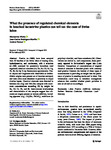What the presence of regulated chemical elements in beached lacustrine plastics can tell us: the case of Swiss lakes
| dc.contributor.author | Filella, M | |
| dc.contributor.author | Rodríguez-Murillo, J-C | |
| dc.contributor.author | Turner, Andrew | |
| dc.date.accessioned | 2021-10-11T08:38:41Z | |
| dc.date.issued | 2021-11 | |
| dc.identifier.issn | 0167-6369 | |
| dc.identifier.issn | 1573-2959 | |
| dc.identifier.other | 693 | |
| dc.identifier.uri | http://hdl.handle.net/10026.1/18034 | |
| dc.description.abstract |
<jats:title>Abstract</jats:title><jats:p>Plastics (<jats:italic>n</jats:italic> = 3880) have been sampled from 39 beaches of ten Swiss lakes of varying sizes, hydrodynamics, and catchments, with a selection (<jats:italic>n</jats:italic> = 598) analysed for potentially hazardous (and regulated) chemical elements (As, Ba, Br, Cd, Cr, Hg, Pb, Sb, Se) by X-ray fluorescence spectrometry. Plastic objects and fragments with identifiable or unidentifiable origins were present on all beaches surveyed, and were often most abundant in proximity to major riverine inputs. Chemical elements were detected in between two (Hg) and 340 (Ba) samples with maximum concentrations exceeding 2% by weight for Ba, Cd, Cr, Pb, and Sb. Inter-element relationships and characteristics of the samples suggest that elements are largely present as various additives, including pigments (e.g., Cd<jats:sub>2</jats:sub>SSe, PbCrO<jats:sub>4</jats:sub>), stabilizers (in polyvinyl chloride), and flame retardants (Br). Observations are similar to, and complement, those previously reported in Switzerland’s largest lake (Lake Geneva). Comparison of concentrations of targeted chemical elements in beached plastic with currently used plastics illustrate the interest of these types of measurements in providing an insight into the persistence of plastics in standing stocks and in lakes. This information could help to introduce management schemes that consider whether plastic pollution is new or old and act accordingly.</jats:p> | |
| dc.format.extent | 693- | |
| dc.format.medium | Electronic | |
| dc.language | en | |
| dc.language.iso | en | |
| dc.publisher | Springer (part of Springer Nature) | |
| dc.subject | Lakes | |
| dc.subject | Plastics | |
| dc.subject | Additives | |
| dc.subject | Antimony | |
| dc.subject | Barium | |
| dc.subject | Bromine | |
| dc.subject | Cadmium | |
| dc.subject | Chromium | |
| dc.subject | Lead | |
| dc.subject | Mercury | |
| dc.title | What the presence of regulated chemical elements in beached lacustrine plastics can tell us: the case of Swiss lakes | |
| dc.type | journal-article | |
| dc.type | Journal Article | |
| plymouth.author-url | https://www.webofscience.com/api/gateway?GWVersion=2&SrcApp=PARTNER_APP&SrcAuth=LinksAMR&KeyUT=WOS:000703887600003&DestLinkType=FullRecord&DestApp=ALL_WOS&UsrCustomerID=11bb513d99f797142bcfeffcc58ea008 | |
| plymouth.issue | 11 | |
| plymouth.volume | 193 | |
| plymouth.publication-status | Published | |
| plymouth.journal | Environmental Monitoring and Assessment | |
| dc.identifier.doi | 10.1007/s10661-021-09384-5 | |
| plymouth.organisational-group | /Plymouth | |
| plymouth.organisational-group | /Plymouth/Faculty of Science and Engineering | |
| plymouth.organisational-group | /Plymouth/Faculty of Science and Engineering/School of Geography, Earth and Environmental Sciences | |
| plymouth.organisational-group | /Plymouth/REF 2021 Researchers by UoA | |
| plymouth.organisational-group | /Plymouth/REF 2021 Researchers by UoA/UoA07 Earth Systems and Environmental Sciences | |
| plymouth.organisational-group | /Plymouth/Research Groups | |
| plymouth.organisational-group | /Plymouth/Research Groups/BEACh | |
| plymouth.organisational-group | /Plymouth/Research Groups/Marine Institute | |
| plymouth.organisational-group | /Plymouth/Users by role | |
| plymouth.organisational-group | /Plymouth/Users by role/Academics | |
| dc.publisher.place | Netherlands | |
| dcterms.dateAccepted | 2021-08-10 | |
| dc.rights.embargodate | 2021-10-12 | |
| dc.identifier.eissn | 1573-2959 | |
| dc.rights.embargoperiod | Not known | |
| rioxxterms.versionofrecord | 10.1007/s10661-021-09384-5 | |
| rioxxterms.licenseref.uri | http://www.rioxx.net/licenses/all-rights-reserved | |
| rioxxterms.licenseref.startdate | 2021-11 | |
| rioxxterms.type | Journal Article/Review |


